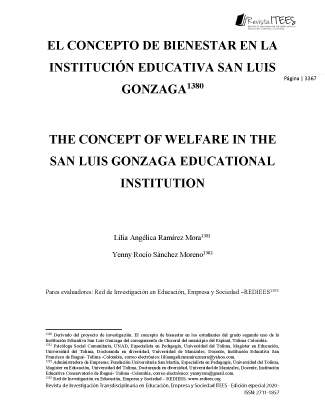CLXXVII. THE CONCEPT OF WELFARE IN THE SAN LUIS GONZAGA EDUCATIONAL INSTITUTION
##plugins.themes.bootstrap3.article.main##
Abstract
This research work addresses the theme of welfare that underlies the conceptions, integral of
the students of grade 2-01 of the San Luis Gonzaga Educational Institution of Chicoral
Espinal - Tolima Colombia., in marking within the current regulations for basic education. It
gives an account of the creation of the school in Colombia, the rights of children, the history
of the guidance offices in Colombia and the context of the population under study that is in
grade 2-01 of said Institution. It presents an analysis of how the concept of Wellbeing has
evolved in school over time, it shows the analysis of both the students' concepts and the
documents present in the Colombian educational system as evidenced by its objectives.
The methodology used is the qualitative approach, with the interview technique supported
by the questionnaire instrument with which the information is collected and the results of the
welfar concept that the students have are presented. For data analysis, the information was
grouped into two categories: Educational Institution and Welfare. With the work carried out,
it is possible to conclude that the concept of Well-being is linked to different aspects such as:
coexistence, physical aspects and care immersed in the school.
Download Statistics
##plugins.themes.bootstrap3.article.details##
welfare, students, educational institution, coexistence pact, guidance, guiding teacher, Diversified Middle Education Institutes (INEM), Institutional Educational Project (PEI).
Kinesis.
Diaz, M. (2016). Convivencia Escolar y Prevencion de la Violencia. Ministerio de Educación
Cultura y Deporte. Recuperado de:
http://www.aulaviolenciadegeneroenlocal.es/consejosescolares/archivos/Convivenci
a_escolar_y_prevencion_de_violencia.pdf
Garces, J. (2016). Iimpacto de los Subsidios Escolares en el Rendimiento Académico: El
Programa de Restaurantes Escolares de Medellín. Evaluación del Impacto del PRE
en el Rendimiento Académico. Recuperado de:
https://repository.eafit.edu.co/bitstream/handle/10784/1434/GarcesCeballos_JoseDa
vid_2013.pdf?sequence=1&isAllowed=y
Guía pedagógica para la convivencia escolar. (s.f.). ¿Qué puedo hacer para fortalecer la
Convivencia Escolar? Recuperado de:
http://www.colombiaaprende.edu.co/html/micrositios/1752/articles342060_archivo_pdf.pdf.
Jimenez, H. (2013). Acceder a la educación superior, un problema cultural. Universidad del
Tolima. Ibagué. Recuperado de:
http://repository.ut.edu.co/bitstream/001/991/1/RIUT-BHA-spa-2014-
Acceder%20a%20la%20educaci%C3%B3n%20superior%20un%20problema%20c
ultural.pdf.
Ministerio de Educación Nacional. (2013). Ley de Convivencia Escolar. Recuperado de:
http://www.mineducacion.gov.co/1621/w3-article-322486.html
Mosquera, E. (2013). Sistema general de orientacion escolar. Bogota, D.C.
Narvaes, L. (2013). La convivencia escolar cuestion humana. Reflexión acerca del rol y la
función de la orientación escolar en asuntos de convivencia. Bogota, D.C.: Urbana
Comunicaciones S.A.S. Recuperadode:
http://www.fundacionparalareconciliacion.org/documentos/upload/31032016_339p
m_56fd990dcdd7a.pdf
Quintero, D. (1994). Principios de Orientación Escolar. Guía para Estudiantes de
Licenciatura. Tunja, Boyaca, Colombia: UPTC.
Saiz, J. (2016). Instituto Nacional de Evaluación Educativa. Recuperado de:
http://blog.educalab.es/inee/





